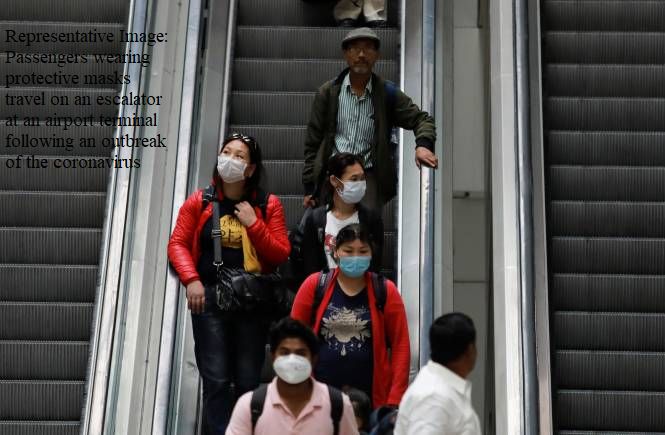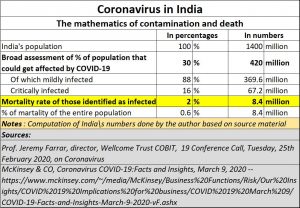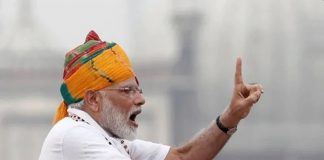https://www.moneycontrol.com/news/business/coronavirus-pandemic-the-risk-of-a-contagion-in-india-5065321.html
Coronavirus confirms government apathy for human lives
RN Bhaskar — March 24, 2020
Testing and more testing is only way to know the extent of the spread of the coronavirus in the country.
India is in a lockdown, trying to evade the rampaging coronavirus that has killed more than 16,588 people and infected more than 381,649 across the world.
But is it a case of closing the stable after the virus has bolted? The country has, so far, reported 499 infections and nine deaths but experts fear the numbers don’t tell the story.
The admission halls of the two largest government and municipal hospitals in Mumbai – JJ Hospital and KEM Hospital—offer a glimpse into what India may be up against.
Before the lockdown came, there were long queues and the crowd was almost stifling. There couldn’t have been a more conducive environment for the virus to spread. But the gravity of the situation seemed to be lost on the government, which went about shutting malls, cinema houses and even schools, forgetting that hospitals are one of the biggest sources of infections.
It was on March 22, as infections began to rise in the city, that the railways decided to stop Mumbai’s local trains that carry around 7.5 million people every day. The trains are packed. They are so crowded that railways even has a term for it “super-dense crush load”. It would have needed only one infected person to trigger a chain of infections.
India reported its first coronavirus case on January 30 and it took almost two months for the movement of people to be curbed.
The images of migrant workers crowding stations in the city and neighbouring Pune to get back home after the shutdown announcement only add to the dread of how far the virus could reach.
The Kasturba Hospital in Mumbai is the nodal centre for coronavirus testing in the city and where critical cases are quarantined. But the facility lacks even the most basic of hygiene. Why would people want to go there? Many braved these conditions, waited for hours but left without getting tested.
And without testing, there is no way of knowing the extent of infection in Mumbai or India. It was only recently that KEM Hospital, too, was allowed to conduct tests but a city of 18.4 million people needs more.
The Union government has authorised 12 private clinics to do the testing across the country, five of which are in Mumbai. These clinics have several branches which can act as collection centres.
Do the math
The math is worrying. Professor Jeremy Farrar, a director with Wellcome Trust and an expert on infectious tropical diseases, has said the rate of spread of COVID-19, the illness caused by the novel coronavirus, will depend on what is known as the “R-naught”. In the case of this epidemic, the R-naught (reproduction number) is believed to be three. “… if I had the infection today, I would pass it on to approximately three other people. That doesn’t sound a very big number until you think that those three will pass it onto three others and those people pass it on to three others,” he said in a conference call on the coronavirus with global investors on February 25, 2020.
Thus, one person will pass on the infection to three which would become 9, then 27 and then 729… all within hours or days. That is why containment is so crucial.
During the 2009 H1N1 swine flu pandemic, 16 percent of the world’s population was infected, said Farrar, who has worked extensively on the flu and Ebola. “And I think we can assume that that would be close to double that,” the professor, who is now in self-isolation in Oxford, said of the coronavirus.
In other words, almost 30 percent of the world’s population could get affected. The numbers will be higher in countries where health services are primitive and lower where containment is well managed.
“I would stick to about a 0.5 case fatality rate [for the world]. . . I would still stick with an attack rate of a median of about 30% of the world’s population that would get infected with this on a range somewhere between 25 and 40,” he said.
Now, extrapolate these numbers for Mumbai. The city has a population of 18.4 million. You can expect at least 30 percent, if not more, to get affected.
Almost 88 percent of them will be mildly infected and get cured with some isolation at home. Around 12 percent will be critical, which will require medicare facilities. Even they are provided good facilities, around 2 percent of the infected (or 0.6 percent of the total population) could die. This means around 368,000 people could die in Mumbai, even if proper care is provided.
If we do the same math for India, a country of 1.4 billion people, 2 percent of 30 percent of the population means 8.4 million people. These numbers could soar if the outbreak is not dealt with properly.
There are lessons to be learnt from Singapore, even though its area and population are much smaller. You will not see many people wearing masks. Schools are not closed, nor are offices. But, monitoring systems are in place in schools, offices, at stations and other public places.
Singapore has 509 infections and reported its first fatalities on March 21, which saw the city-state ban short-time visitors.
A person suspected of coronavirus is immediately isolated and then treated. Treatment is free for Singaporeans as well as foreigners, as the government knows the cost of not treating a person could be a lot higher. The state is also giving small sums to daily-wagers deprived of their sources of income.
Can India do a Singapore? Yes, if right policies are pursued, more of that in Part II of the series.











































COMMENTS